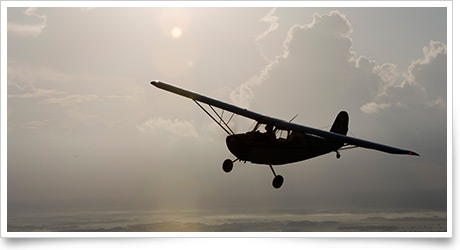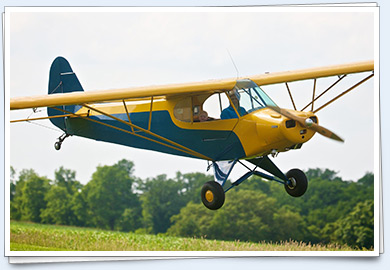| |||||
| | |||||
Training TipsHigh dew point, hidden hazard
In one such place, this seemingly benign weather observation was registered later in the day that the heat had peaked: 201453Z 36008KT 10SM FEW100 28/21 A2991 RMK AO2 SLP125 6//// T02830211 56010.
With light winds from the north, good visibility, and only a few clouds at 10,000 feet, what was not to like about the conditions?
The temperature (in the low 80s, converted from 28 degrees Celsius) was high but no longer extreme. The single note of caution for alert pilots lay to the right of the slash (/) in the 28/21 temperature and dew-point values given in the observation.
“A high dew point is bad news, usually,” said AOPA Pilot Editor at Large Thomas A. Horne. “A high dew point equals more moisture in the air. More moisture equals more potential warming of the atmosphere, and therefore, instability.”
And atmospheric instability is closely associated with the potential for thunderstorms.
“Once thermals, fronts, and other lifting forces go to work on air masses with high dew points, towering cumulus or cumulonimbus clouds can soon follow,” Horne wrote in the AOPA Pilot article “Wx Watch: Dew Point Review.” “Cooling takes place as moisture-laden air is lifted higher and higher in unstable air masses. Most severe thunderstorms (those with 50-plus-knot surface winds, three-quarter-inch hail, or tornadoes) happen in air masses with dew points above 70 degrees F (21 degrees C).” The Air Safety Institute’s WeatherWise: Air Masses and Fronts online course further explores the role of dew point in weather development.
High dew points may also be a harbinger of imminent frontal passage, as southerly flows pump moisture-laden air into the area, he said.
But not always. A high dew point may not be a match for extremely high temperatures. On a day when the temperature and dew point at AOPA headquarters in Frederick, Md., stood at 37/21 Celsius, Horne was not expecting convective activity.
“There isn’t enough moisture to make a TRW because the high temps have dried the air,” he said.
Horne reminded pilots of another cause for caution on days when the number to the right of the slash is high: The potential for carburetor icing increases because there is more moisture that could freeze in the venturi of an aircraft engine’s carburetor. Flight Training NewsPhoenix East turns to iPad use in trainingPhoenix East Aviation in Daytona Beach, Fla., has begun using Apple iPads in cockpit and classroom training. The tablets are used for charts, flight planning, and selected textbook training to augment ground school, and have been integrated into both the FAR Part 141 and Part 61 programs. Airlines including United, Alaska, and Delta have started using iPads in the cockpit, according to Phoenix East CEO Ghassan Reslan. “Phoenix East Aviation students will now find this aspect of the transition from training to commercial aviation employment straightforward and uncomplicated,” he said. July Facebook Chat to focus on ATCAre you nervous about communicating with air traffic controllers? Uncertain about your phraseology? Come learn all about ATC on July 10 for Flight Training’s monthly live Facebook chat. Our guest chatter is AOPA Aviation Technical Specialist Aaron Pifer, who was an air traffic controller in training. Join us at 3 p.m. Eastern time and bring your questions; click here to view previous chat transcripts or set up an email reminder. K-State Salina students get Cirrus timeFour aviation students at Kansas State University-Salina received cockpit time and instruction in a Cirrus SR22. The Connor Burton Aviation Foundation provided access to the aircraft and instructor. The foundation has subsidized student flying time, attendance at flying competitions and air races, a speaker series, and other activities since 2008, with the goal of upgrading their experience and improving their pilot capabilities. Do you have the big weather picture?Using datalink to navigate weather can be extremely helpful as long as you proceed with caution and understand its limitations. The NTSB recently warned pilots that in-cockpit weather displays may represent conditions up to 15 or 20 minutes older than the age indicates, a situation that could have deadly consequences in severe weather situations. How do you learn to put datalink weather in context with the big picture? Come to sound weather conclusions with the Air Safety Institute’s IFR Insights: Cockpit Weather as you fly simulated trips spanning weather and seasons across the U.S. The course is sponsored by Aircraft Spruce and Specialty Co. and qualifies for AOPA Accident Forgiveness and the FAA Wings program. Take the course >> Tailwheels Etc. moves to LakelandTailwheels Etc., a Florida flight school featured in Flight Training for its successful training practices, has moved from Winter Haven’s Gilbert Airport to Lakeland Linder Regional Airport. The move came after the school’s lease came up for renewal and it could not come to terms with the city, according to the Winter Haven NewsChief.com. Tailwheels joins a new flight school, Bernoulli Flight Academy, at Lakeland. Resuming the journey: Short- and soft-field takeoffsShe’s now comfortable in the cockpit, but AOPA staff member Kathy Dondzila had to refamiliarize herself with short- and soft-field operations so that she’d be prepared for what she is likely to encounter in Alaska. A 1,700-foot grass runway is in her future. Read more >> Training ResourcesPerhaps nontowered airports are new to your experience; what to do there is as mysterious to you as towered airports are to other trainees. Download the Operations at Nontowered Airports Safety Advisor before heading out. Clearly, there is a lot more to using new runways than just knowing lengths, surfaces, and direction.
Did you know that student pilots who join AOPA are three times more likely to complete their flight training? Membership includes unlimited access to aviation information by phone (800/USA-AOPA, weekdays from 8:30 a.m. to 6 p.m. Eastern time) or from Flight Training Online or AOPA Online. If you’re not already a member, join today and get the pilot’s edge. Login information is available online. Learn thunderstorm danger, avoidance in webcast Career PilotSkyWest Airlines celebrates 40 yearsStarting in 1972 with a few six-seat aircraft, SkyWest Airlines recently celebrated its fortieth anniversary and is now one of the largest independent commuter airlines in the world. SkyWest has 315 aircraft and more than 10,000 employees, according to a report in USA Today. CEO and Chairman Jerry Atkin said the company flew just 256 passengers in its first year. In 2011, it carried 24.5 million. SkyWest is based in St. George, Utah. Hawaiian Airlines adds nonstop flights to BrisbaneHawaiian Airlines announced on June 19 that it will begin nonstop service to Brisbane, Australia, on Nov. 27. The company says it is the only U.S. carrier to operate flights to Brisbane. Flights will be operated with Boeing 767-300ER aircraft. Hawaiian has offered daily service to Sydney since 2004. Plane SpotterCessna Cutlass: Commonly complex Training ProductsiPad briefcase from Sporty’sSporty’s has introduced a briefcase designed to work as a flight bag for your iPad. The iPad briefcase includes internal and external pockets for holding accessories such as a charging cable, cleaning cloth, backup battery, or stylus. It can be carried via two handles or a detachable shoulder strap. The bag measures 12 inches by 9 inches by 2 inches. It sells for $39.95. Order online or call 800/776-7897.
Note: Products listed have not been evaluated by ePilot editors unless otherwise noted. AOPA assumes no responsibility for products or services listed or for claims or actions by manufacturers or vendors. Member BenefitsMedical application: What if I forget something?A pilot has had many doctor visits since his last FAA medical in 2004, none involving major medical conditions. Does he need to list every medical visit since 2004, or is there a “statute of limitations”? What if he forgets one and fails to list it? Kathy Yodice, an aviation attorney for AOPA’s Pilot Protection Services, explains why two questions on the form merit special attention. Read more >> BlogsCatching up with … True Course Flight SchoolEighteen months ago, Jeff Vandeyacht bought a flight school to keep it from closing down. How's he doing? Technical Editor Jill Tallman checks in with the owner of True Course Flight School in the Flight Training blog. Target: Upper MidwestEver hear of a mesoscale convective complex? If you live in the upper Midwest, it's likely you had one parked over you recently. AOPA Pilot Editor at Large Thomas A. Horne discusses these fascinating but deadly summer weather patterns in a series of Reporting Points blogs. Learn what they are, how they can change, and how long they can hang around. AOPA Career OpportunitiesEver dream of turning your passion for aviation into a career? We’re looking for a Web graphic designer, aviation technical writer, member services representative, and enewsletter and social media editor. To learn more about other AOPA career opportunities, visit AOPA Online. Community
AVIATION EVENTS & WEATHER
| ||||||||||||||||||||||||||||||||||||

 While much of the country baked in a recent heat wave, temperatures soared to near-record levels in places where truly hot conditions may be experienced only a few days a year.
While much of the country baked in a recent heat wave, temperatures soared to near-record levels in places where truly hot conditions may be experienced only a few days a year.





